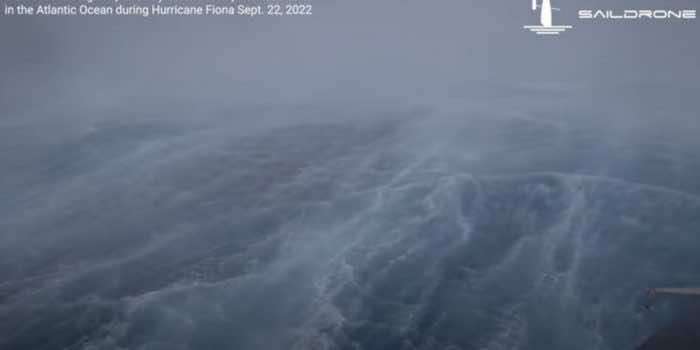Saildrone and the US National Oceanic and Atmospheric Administration (NOAA) sent their storm robots right into Hurricane Fiona, a powerful storm wreaking havoc on Puerto Rico and Canada’s east coast.
The footage, recorded around 360 miles southeast of Bermuda, shows a blue sea and massive waves accompanied by howling winds. Torrential rain and terrifying sea spray can be seen spinning as the vehicle sways and lunges over the rocky surface of the ocean.
The Saildrone Explorer SD 1078 was in the best position on Thursday to acquire never-before-seen footage from within Fiona, the year’s first Category 4 storm, with wave heights approaching 50 feet and speeds over 100 mph.
“[Saildrones are] giving us a completely new view of one of Earth’s most destructive forces,” Saildrone said in a news release.
Beginning Sunday evening, while the storm was still a tropical storm east of Montserrat, four Saildrones engaged with it. The storm became a Category 1 hurricane after colliding with a Saildrone stationed south of Puerto Rico, where Fiona made landfall for the first time. At the start of hurricane season, Saildrone launched its vehicles to collect crucial scientific data in the Atlantic Ocean and the Gulf of Mexico.
Saildrone has launched hurricane-equipped units into the Atlantic for the second year to get data and footage near the storm’s eye. In addition, the firm builds and designs autonomous surface vehicles that collect ocean data to improve storm forecasting, map the ocean floor, and follow various ecosystems.
The California-based business claims that its units have travelled more than 800,000 nautical miles and spent more than 18,000 days at sea gathering climate and ocean mapping data.
“Saildrone is once again demonstrating its ability to provide critical ocean data in the most extreme weather. Hurricane Fiona intensified from a tropical storm to a Category 1 hurricane just before hitting Puerto Rico, causing significant damage and loss of life,” said Richard Jenkins, Saildrone founder and CEO.

“The data Saildrone vehicles are gathering will help the science community better understand rapid intensification, giving people living in our coastal communities more time to prepare.”
Saildrone United 1045 was flown into Category 4 Hurricane Sam in 2021 by Saildrone and NOAA scientists, who also managed to get the first-ever video from within the hurricane.
The partnership between NOAA and Saildrone is a component of a larger initiative to comprehend storm intensification and development. “Uncrewed systems in the air, on the ocean surface, and underwater and aircraft systems have the potential to transform how NOAA meets its mission to understand the environment better,” said Capt. Philip Hall, director of NOAA’s Uncrewed Systems Operations Center.


